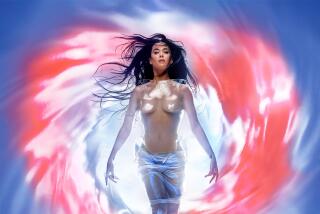SCHULLER STYLE : SHOW-BIZ SIDE OF EASTER EVENTS
Fear not, the Crystal Cathedral once again brings to life its eminently facile, spiritually winsome version of Holy Week and Easter.
In the second annual “The Glory of Easter” (which opened Friday for a 30-day run, to April 13), everything you have come to expect in a Crystal Cathedral staging of holy visions is still there: the reverence for dramatic oversimplification, the zeal for theatrical exhibitionism.
Indeed, the flying angels have never been prettier; the storm effects more earth-splitting; the Roman stallions more regal; the Jerusalem multitudes more teeming and babbling.
And the Crystal Cathedral has never told the Easter story--from triumphant entry into Jerusalem to the emptied tomb--more briskly, neatly or wholesomely folksy.
Inspiring? A matter of viewpoint.
Entertaining? Oh, yes.
But the Crystal Cathedral has always been known for unfettered showmanship in its stage productions and a devotion to a kind of big-top mentality that borders on theatrical bombast.
This has been true of “The Glory of Christmas,” the much-touted Nativity pageant that has been presented at the 2,900-seat, 12-story all-glass edifice in Garden Grove since 1981.
This is again true of “The Glory of Easter,” which the Rev. Robert Schuller--who built this church on the upbeat doctrine of “possibility thinking”--introduced a year ago with even mightier hype, costlier staging ($1 million) and to larger audiences (83,000 attendance).
Mind you, not all of “The Glory of Easter” is on the grandiose side.
The color schemes by production designer Charles Lisanby, a veteran of Radio City Music Hall and television spectaculars, and costume creator Richard Bostard are decorously muted. The lighting effects by Broadway veteran Ken Billington (“Sweeney Todd”), especially when tracking Christ, have a marvelous simplicity.
And the storytelling in this year’s “The Glory of Easter”--again directed by Conwell Worthington II and Michael Coleman, based on Paul David Dunn’s script--if still hardly the model of restraint, is a good deal less high-pitched.
Although the production is a smartly paced 70 minutes, the events are now allowed more time to unfold calmly, apart from the booming music track, the milling extras, the menagerie of jaguars, peacocks, camels and lambs. Now, scenes of Christ (Miles Herter) conversing with the tiny flock have a greater quietude--indeed, a sacred dignity, free of the sideshow intrusions.
Mercifully, the production is also spared much of last year’s histrionics. Herod is still all campy effeteness, but this year’s Sanhedrin patriarchs and Roman bureaucrats are less given to shouting their lines or gesturing wildly. (Far more subdued is the recorded narration delivered by Gregory Peck.)
And Herter, as this year’s Christ, is less the charismatic militant, more likable and natural, a performance less provocative, perhaps, but more thoughtful and modulated.
But ultimately everyone, Christ included, is upstaged by the hippodromic special effects unleashed for the Big Scenes--the Crucifixion and the Resurrection.
There are the thunder rolls, the lightning flashes, the laser zaps, the fireworks, the earthquake. Plus the soaring music, fleeing mobs, swooping high-wire angels. The overall effect? A grand three-ring Easter spectacle.
More to Read
The biggest entertainment stories
Get our big stories about Hollywood, film, television, music, arts, culture and more right in your inbox as soon as they publish.
You may occasionally receive promotional content from the Los Angeles Times.










